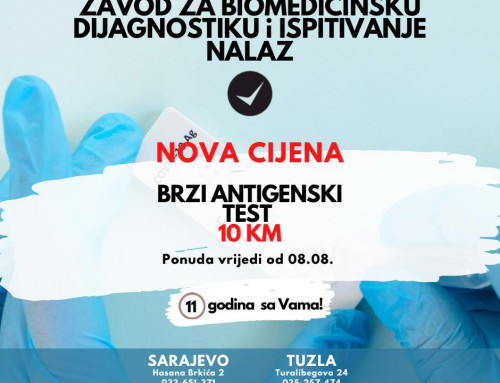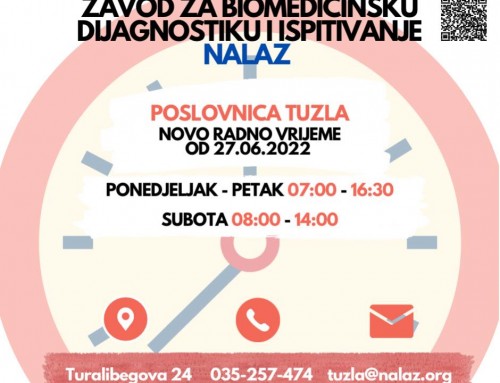Prema podacima Zavoda za statistiku FBiH, u 2010. godini od raka su umrle 4093 osobe (57,7% muškaraca i 42,3% žena). Samo mali broj uzročnika karcinoma je poznat. Među poznatim uzročnicima su bakterije i virusi: Helycobacter pilori – uzročnik karcinoma želuca; Hepatitis C i B virusi – uzročnici karcinoma jetre; Humani papilloma virus – uzročnici karcinoma grlića maternice itd.
Maligna oboljenja (malignomi, karcinomi) predstavljaju javnozdravstveni problem u svim zemljama svijeta. U Federaciji BiH, godišnje, od ove bolesti oboli oko 222 muškarca i 192 žene na 100.000 stanovnika. Prema podatcima Zavoda za statistiku FBiH, u 2010. godini od raka su umrle 4093 osobe (57,7% muškaraca i 42,3% žena). Vodeći uzrok smrti muškaraca od raka je rak pluća (33,9%), a žena rak dojke (14,1%).
Najčešćih lokalizacija raka u muškaraca su rak dišnog sistema (traheja, bronhi, pluća), zatim rak prostate i rak mokraćnog mjehura. Sa druge strane, najčešćih lokalizacija raka u žena su: dojka, grlić maternice, pluća, bronh i traheja. Među najčešćih 10 malignoma, i kod žena i kod muškaraca, su rak: želudca, debelog crijeva, mozga i gušterače.
Od malignoma obolijevaju svi: novorođenčad, djeca, adolescenti, starci! Raspon dobi oboljelih je 0 godina do 99 godina (i za muškarce i za žene). Prosječna dob oboljelih je 62 godine.
Uzrok nastanka karcinoma u večini slučajeva ostaje nepoznat. Samo mali broj uzročnika karcinoma je poznat. Među poznatim uzročnicima su bakterije i virusi: Helycobacter pilori – uzročnik karcinoma želuca; Hepatitis C i B virusi – uzročnici karcinoma jetre; Humani papilloma virus – uzročnici karcinoma grlića maternice itd.
Uzrok nastanka karcinom grlića materice je u 99,7% slučajeva dugotrajna (perzistentna) infekcija humanim papilomavirusom (HPV). Većina takvih infekcija je prolaznog karaktera i ne dovodi do razvoja karcinoma grlića materice. Međutim, mali ali značajan broj HPV infekcija napreduje do nastanka karcinoma. Prisustvo virusa u inficiranim ćelijama, kao i aktivacija ćelija da produkuju neke proteine dovodi do promjena u ćelijama, koje se u početku definišu kao displazije, prekanceroze i kasnije kancer. Ovim promjenama doprinosi prekomjerna sinteza virusnih onkoproteina E6 i E7, koja narušava kontrolni mehanizam ćelijskog ciklusa, što dovodi do maligne transformacije i prekanceroznih promjena ćelija. Svi genotipovi virusa, iz grupe tzv. visokorizičnih, u različitom procentu izazivaju rak. Istraživanja sprovedena na uzorcima karcinoma grlića materice su pokazala da su genotipovi HPV-16 i HPV-18 zastupljeni u približno 70% slučajeva širom svijeta.
Dijagnostičke metode zasnovane na detekciji virusnog genoma (HPV DNA) pokazuju samo da je virus prisutan u ćeliji, ali ne daju informaciju o onkogenoj aktivnosti virusa, niti da li infekcija ima prolazni ili dugotrajan karakter. Novije tehnologije preporučuju nove koncepte koji se više fokusiraju na detekciju specifičnijih faktora rizika poput otkrivanja nivoa izražavanja virusnih onkogena E6 i E7, koji imaju ključnu ulogu u malignoj transformaciji inficirane ćelije. Nivo izražavanja gena se mjeri detekcijom glasničke ribonukleinske kiseline (mRNA).
Detekcija mRNA onkoproteina HPV E6 i E7 je potvrda toga, da je u inficiranoj ćeliji prisutna dugotrajna sinteza virusnih onkoproteina, te da infekcija nema samo prolazni karakter. Stoga, ovakav način testiranja ima mnogo veći klinički značaj jer prepoznaje pacijentice koje su pod direktnim rizikom od razvoja karcinoma grlića materice. Medicinska prediktivna vrijednost detekcije HPV E6/E7 mRNA je veća u odnosu na testove zasnovane samo na otkrivanju prisustva HPV infekcije DNA testiranjem. Pokazalo se da se uz pomoć mRNA testiranja može isključiti veći broj žena sa normalnom citologijom i histologijom, tj., da test ima bolje parametre za isključivanje pacijentica koje nisu pod rizikom od razvoja karcinoma grlića materice.
Pošto je kod pacijentica mlađih od 30 godina veća zastupljenost prolaznih HPV infekcija, izbor HPV DNA testa kod ove populacije je od upitnog kliničkog značaja. Zbog toga su testovi detekcije mRNA i dugotrajne virusne onkogene aktivnosti od mnogo većeg prognostičkog i kliničkog značaja kod ove populacije žena u odnosu na metode detekcije virusne DNA.
Prof.dr. Mirsada Hukić, MD, PhD
Mr.sci.biomed. Irma Salimović- Bešić, MSc. of biochemistry
Based on the data from the Institute for Statistics of the Federation of Bosnia and Herzegovina, 4093 individuals have died from cancer (57.7% men and 42.3% women) in the year 2010. Only a small number of causes is known. Among the known causes of cancer are viruses and bacterias such as: Helycobacter pilori – stomach cancer; Hepatitis C and B virus – liver cancer; Human papilloma virus (HPV) – cervical cancer, and so on.
Malignancies represent a common problem in every country. In the Federation of Bosnia and Herzegovina, on avarage, 222 men and 192 women out of 100 000 per year are affecetd by this disease. Based on the data from the Institute for Statistics of the Federation of Bosnia and Herzegovina, 4093 individuals have died from cancer (57.7% men and 42.3% women) in the year 2010. The leading cause of death for men is the lung cancer (33.9%) and for women is the breast cancer (14.1%).
The most common cancer localization in men is the respiratory tract (trachea, bronchii, lungs) followed by the prostate and the urinary bladder cancer. On the other hand, the most common localizations of cancer in women are: breast, cervix, lungs, bronchii and trachea. Among 10 most common malignancies in men and women are: stomach, colon, brain and pancrease.
Malignancies are found also in the new born babies, children, teenagers and elderly. The range of age of individuals affeceted is from 0 to 99 (both for men and women). The avarage age of affecetd bz the cancer is 62 years of age. The reason for developing cancer in most cases is unknown. Only a small number of causes is known. Among the known causes of cancer are viruses and bacterias such as: Helycobacter pilori – stomach cancer; Hepatitis C and B virus – liver cancer; Human papilloma virus (HPV) – cervical cancer, and so on.
Cervical cancer is caused by the long-term (persistent) high-risk HPV infection in 99,7% of cases. Most HPV infections are transient and do not lead to cancer of the cervix. However, a small but significant number of HPV infections progress to such cancers. Excessive synthesis of viral oncoproteins E6 and E7 disrupt the mechanisms controlling the cell cycle, leading to malignant transformation of precancerous changes in infected cells. Researches carried out on samples of cervical carcinoma showed that the genotypes of HPV-16 and HPV-18 are represented in approximately 70% of cases worldwide.
Diagnostic methods based on the detection of viral genome (HPV DNA) indicate only that the virus is present in the cell, but does not provide information on viral oncogenic activity, or that the infaction has transient or long-lasting character. Current technologies suggest new concepts that are focused on detection of more specific risk factors- such as the detection of overexpression of viral oncogenes E6 and E7, which play a critical role in malignant transformation of the infected cells. The level of gene expression is measured by detecting the gene transcripts (mRNA) in this case.
mRNA detection of HPV oncoproteins E6 and E7 is a confirmation of the fact, that the infected cell established long-term synthesis of viral oncoproteins, and that infection is not only temporary. Therefore, such a test has a much greater clinical significance due to efficient triage of the patients who are under the direct risk of developing cervical cancer. Medical predictive value of detection of HPV E6/E7 mRNA was higher compared to tests based only on detecting the presence of HPV infection (detecting the viral genome). It turned out that testing for the overexpression of HPV oncogenes can exclude a larger number of women with normal cervical cytology and histology, i.e., that test has a better performance for the exclusion of women who are not at risk of developing cervical cancer.
Women under the age of 30 have higher prevalence of transient HPV infections and HPV DNA testing in this population is of questionable clinical significance. Therefore, detection of oncogenic HPV mRNA and consequently persistant viral oncogenic activity is of higher predictive and clinical value in relation to methods of detection of viral DNA for this population of women.
Institute for biomedical diagnostics and research- NALAZ pays close attention to the reproductive health of women. A special place in the diagnostics there occupies diagnosis of human papillomavirus (HPV) infection and predicting the course and outcome of infection. Institute for biomedical diagnostics and research- NALAZ is the only institution in B&H, which owns the NASBA technology and who can, based on measuring the levels of mRNA for viral oncoproteins E6 and E7, monitor virus activity and determine the moment when persistent infection becomes invasive, leading to the emergence of cancer.
Prof.dr. Mirsada Hukić, MD, PhD
Mr.sci.biomed. Irma Salimović- Bešić, MSc. of biochemistry



